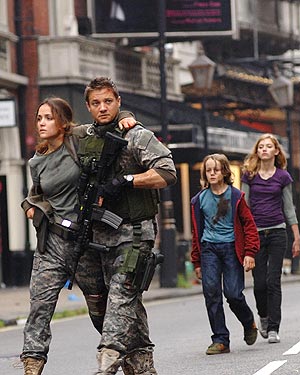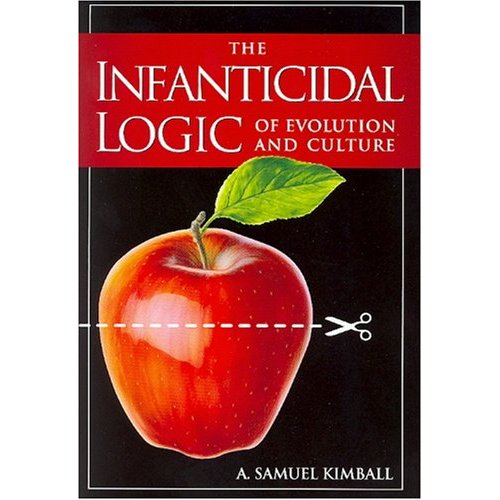…in which I take a critical look at some of my 11th grader’s scary stories.
(Check out last year’s batch, if you like).
Rotting Jack O’ Lanterns w/ Flies (2007)
Felici@ Noll*y’s “Eyes of a Baby” makes stunning use of what I like to call “the fetal voice.” Noll*y’s narrative begins in a “bubble […] so safe and warm with extra soft walls.” However, her hapless narrator is soon confronted with “monsters” who “torture” the poor kid, ripping it out of its safe haven, depriving it of its immediate source of food. The poor dear ends up in a “jail cell with big bars,” contemplating a strange new existence in a world populated by demons. Noll*y’s narrative captures the jarring dissonance of new beginnings contrasted with the ever-present ideal of a perfect, unattainable “safe haven.”
L@ur@ Cunningh@m submitted a trio of vignettes, each as unfinished as a fetus, each showing some serious promise as contenders in an Anne Rice parody contest–only I think Cunningh@m’s serious about her work. In “Implied Consent,” she dips into her idea of an adult vampire world, one reminiscent of the early nineties goth scene. She also uses the phrase “nary a word.” Yes, “nary.” Ugh. In “Duality,” she takes a stab at a postmodern trope–the characters in the story are being written into existence by other characters in the story (somebody get Charlie Kaufman on the phone). In the blandly-titled “Something,” Cunningh@m demonstrates public high school’s complete failure to teach human anatomy with this clunker: “Hot bile rose to the back of her throat.” Bile is produced by the liver, sweetheart. Maybe it’s just a very, very complicated metaphor.
Sh@t@vi@ E@dy’s “Down in the Crowd,” written as a screenplay, finds rumors to be the root of all evil. I’m not sure exactly what happened in E@dy’s tale, but I do know that gossip and misinformation are sites of extreme horror for her. Also, there’s a predominate preoccupation with “the cool kids” and the “not cool kids”–social scientists are now clamoring to adopt these specialized terms as their own.
M@tik@ Bl@l@rk’s “Taken” begins in media res, a bold step that none of the other young writers attempted. Good for her! Unfortunately, Bl@l@rk’s cluttered imagery and frantic pace leave no room for the reader to have any sense of what’s going on. In the end, she pulls what is to be a recurring motif in many of these stories: “It was all just a dream” (alternately: “It was all just a nightmare”). So says I: “It was all just a cop out.” People didn’t like that shit on Dallas back in the 1980s, and I don’t like it now.
Far more ambitious is Ch@ntel R**d*r’s “Fight of the Gods,” written entirely in a marvelous backwoods dialect (at one point, her narrator points out that the “man war havin’ a Caesar,”–he means “seizure”–a line compounded in semiotic resonance when one considers the fact that Caesar suffered from epileptic fits. I applaud R**d*r’s Joycean wordplay!) After thirty-five pages, it became clear that R**d*r had submitted not a self-contained story, but the initial chapter of a book about demonic possession over the ages of man. She says she has more, and I’d love to read it.
Mel@nie River@’s “Breathe,” like a number of the stories this year, seems to take several of its cues from the recent Saw franchise: torture chambers as puzzles, ambitious killers, that sort of thing. River@’s story stands out on several counts, beginning with her adventurous use of verbs: in “Breathe,” we find that bones can be “emasculated” (these are not metaphorical bones; she is referring to ulnas and tibias and metatarsils and shit like that). There is a fascinating episode where a bus driver bites a hapless victim, who astoundingly replies: “Who are you to put your hands on someone else’s child, huh?!” I was astounded because that’s just what I say when a weirdo stranger bites me unprovoked out of nowhere. It turns out that the bus driver is a killer, and not just “a normal killer, he was an advanced killer.” Coming soon to a theater near you: Advanced Killers 4: The Matriculation.
As its title suggests, D@nchelle Jon*s’s “Scary Story” is a self-reflexive postmodern comment that seeks to pull at the very roots of just what can qualify as a “scary story,” or for that matter, as a story at all! Who says you have to have mood, tone, or setting? What traditionalists (patriarchalists, no doubt!) decree that a story should have a beginning, middle and end? Jon*s attacks our notions of just what the narrative arts can do, leaving us scratching our heads as we applaud her audacity.
In “REVENGE OF THE EX!!!!!”, M@h@ Mi@n also pushes the limits of traditional writing, this time challenging those awful standards of typography and punctuation: why can’t a story be typed in italicized, 18-point font? Isn’t it obvious that some questions deserve multiple question marks???? And who’s to say that multiple exclamation marks are redundant?!!!!?!?!?!?!?!?!?!?
Sh@net@ Oliv*r’s “Black Outs” examines the mood swings typical of teenagers, pushing those mood swings into the fascinating trope of split personalities. Also, the first half of Oliv*r’s story consists of rhymed couplets, a rhetorical strategy that mirrors the tension between conflict and harmony inherent in every person afflicted with multiple personality disorder.
Finally, M@j@ C@v@r makes a bold move by naming her story “Extra Credit.” Again, I can only assume this is a kind of postmodern tongue-in-cheek gesture on C@v@r’s part, a reference to the fact that I offered the “Scary Story” assignment as a way to earn–you guessed it–extra credit. Nothing slips by these kids. C@v@r is an innovator in what I like to call the “I-filled-up-all-the-lines-on-the-paper-so-now-the-story’s-over-regardless-of-the fact-that-so-much-still-remains-unresolved” style of writing. Courageously sacrificing any sense of closure, C@v@r instead opts for this stunning closer, shifting jarringly from third-person omniscient to first-person singular: “I only need a point from only a B and I really need a B, okay?” Sorry, sweetheart, I don’t think that’ll quite do it.

















